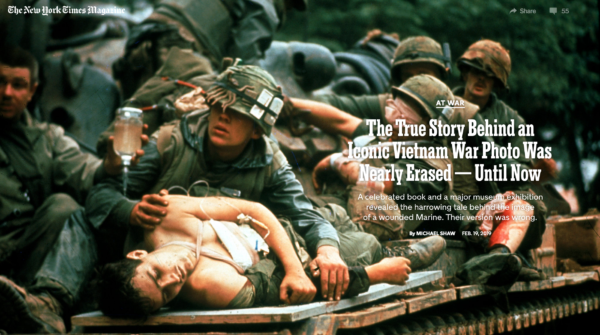Notes
Vietnam to South Lawn, Vatican to Award Season: Our Social Week

Our feeds this week were dialed in to the publication and reception of RTP founder Michael Shaw’s article in The New York Times Magazine. Michael spent 10 months researching the story, which follows the curious history of an iconic Vietnam War photograph and its elusive subject to arrive at some powerful conclusions about memory, journalism, and America’s identity. It’s not to be missed, and neither are the fascinating archival materials and forensic analyses that didn’t make it into the final piece. Luckily we’ve been sharing those via Twitter and Instagram since the article dropped on Tuesday.
Meanwhile, back with the spectacle that is American politics, our visual week in review is a typically unpredictable mix of presidential power, socialism, and… the Pope? Yes, Francis’s clerical sex abuse summit is a challenge to the Church and photo editors alike, and we will be keeping our eyes peeled for creative ways of visualizing what amounts to a behind closed doors news event.
Lastly, February is basically Oscars season for news photography, and this week the industry’s most respected authorities, POY and World Press Photo, each announced the finalists for their yearly contests. You can believe we’ll have more to say about the results—from keen to controversial—as they are announced in the weeks to come.
-Rian Dundon
The photographer, a famed author, and the @Newseum claim the soldier is alive. The Marine eyewitnesses and #DonMcCullin’s never-before-seen pictures prove them wrong. Michael Shaw of RTP tells the story of this iconic Vietnam photo for @NYTimesAtWar. https://t.co/38WLr8u0nB
— Reading The Pictures (@ReadingThePix) February 19, 2019
Many important artifacts are connected to that iconic Vietnam war photo–its true story, finally told, by RTP’s Michael Shaw for @NYTMag. For example, here’s the original ‘68 spread in @LIFE with John Olson’s photos, the key pic double page. https://t.co/rRduPdAAVB @NYTimesAtWar pic.twitter.com/wbUa1lMENt
— Reading The Pictures (@ReadingThePix) February 20, 2019
If media is going to do it better this time, this is not a good start: the MAD crew. And, ranked bottom to top (poor Gillibrand), media primary also well underway. pic.twitter.com/mEXkEvkvGK
— Reading The Pictures (@ReadingThePix) February 21, 2019
Slings and…. (Impressionistic takes on the @WhiteHouse by DC photojournalists: an ongoing series.) Photo @somogettynews #borderwall #NationalEmergency pic.twitter.com/5l2k6UrDis
— Reading The Pictures (@ReadingThePix) February 15, 2019
Another classic @whitehouse from @davidbutow on #NationalEmergencyDay. Hair raising. Hair on fire. Trump tempest. #notnormal pic.twitter.com/dnxwIDyZbA
— Reading The Pictures (@ReadingThePix) February 15, 2019
Just Don’t Call it #Socialism: Michael Williamson’s photo of Americans outside a free health clinic brings the discussion of “socialism,” and/or more human social policy, into greater focus. By @PhilipPerdue https://t.co/BxTc7OOwKN @mswontheroad @postphoto pic.twitter.com/rqYNFMsW0S
— Reading The Pictures (@ReadingThePix) February 19, 2019
Powerful assignment for #photographers and #photoeditors depicting the church’s deep stain, the coverup, and this week’s #VaticanAbuseSummit. The pic, from @epaphotos in an @guardian piece, speaks to identification and the relative clarity of @Pontifex. https://t.co/9USJpNJiXC pic.twitter.com/Yh2mhRr1U2
— Reading The Pictures (@ReadingThePix) February 21, 2019
Certainly, photos inform others over time. And yes, it’s fascinating how much the @ChrisHondros photo of Samar Hassan, after US soldiers attacked her family’s car in Iraq in ’05, speaks to @jbmoorephoto‘s US border photo, a @WorldPressPhoto finalist. Senseless traumas, both. pic.twitter.com/09H7KIunEG
— Reading The Pictures (@ReadingThePix) February 21, 2019
Kicking off award season, take a look at the last four @WHNPA “Eyes of History” contest photos of the year. 2019’s #1 is Pence on periphery of a GOP Senate meeting. Overall: the segue into disconnection. 📷 @pennstatetom @rollcall @jimwatson_afp @andyharnik @AP @dougmillsnyt pic.twitter.com/HycJAD9qp3
— Reading The Pictures (@ReadingThePix) February 21, 2019


Reactions
Comments Powered by Disqus